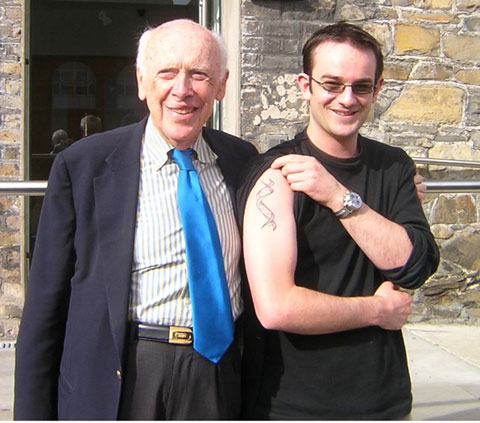
Used with permission from Science Ink by Carl Zimmer, Sterling Publishing © 2011 |
This Tuesday, Carl Zimmer introduced the Terry Gilliam film Twelve Monkeys at the Coolidge Corner Theatre with a talk about viruses. On Wednesday, the popular science writer appeared at the Harvard Museum of Natural History to give a lecture on tattoos.
>> PHOTOS: Selections from Science Ink <<
Over the last four years, Zimmer has become the nation's foremost chronicler of scientific skin art. In August of 2007, he put a call out on the Loom, his blog for Discover magazine. "If anyone wants to send me a jpg, I'll post it," he wrote. "If you're worried about tenure, just let me know how the tattoo represents the object of your study."
Tattooed scientists deluged Zimmer with so many pictures that he created a separate blog called the Science Tattoo Emporium. In between other, more high-falutin' projects — Zimmer is best-known for his work on evolution and parasites — he amassed a staggering collection of tats representing all the major scientific disciplines. Last month, Zimmer released a book, Science Ink: Tattoos of the Science Obsessed.
"Scientists have been tickled by it," Zimmer told me in a phone call Tuesday morning. "It turns out to be a funny, surprising way of appreciating science and who scientists are."
Zimmer finds science tattoos to be of anthropological interest. "Tattoos go back many thousands of years," he said. "The fact that there's this hidden subculture is certainly interesting. They're a little tribe."
That tribe's commonalities? "Great attention to detail," he said. "Some of these tattoos are really insanely detailed and precise." Zimmer was wowed by the meticulousness of a tattoo running down the length of someone's arm that illustrated each step of a gene creating a protein, and another that depicts the Cretaceous-Tertiary extinction event — with dinosaurs and "all sorts of other animals getting killed off by flaming pieces of rock coming out of the sky."
To prepare for his Boston appearance, Zimmer reached out to local participants, including Melissa Schumacher (Cantor's Theorem), Maya Weinstock (a constellation), and Colm O'Dushlaine, a fellow at the Broad Institute with a giant DNA tattoo on his shoulder.
"He sent me a picture where he is at a scientific conference, baring his shoulder, standing next to James Watson, who discovered the structure of DNA," Zimmer said. "Watson is looking a little confused."